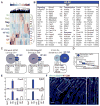Signaling Networks among Stem Cell Precursors, Transit-Amplifying Progenitors, and their Niche in Developing Hair Follicles
- PMID: 27009580
- PMCID: PMC4826467
- DOI: 10.1016/j.celrep.2016.02.078
Signaling Networks among Stem Cell Precursors, Transit-Amplifying Progenitors, and their Niche in Developing Hair Follicles
Abstract
The hair follicle (HF) is a complex miniorgan that serves as an ideal model system to study stem cell (SC) interactions with the niche during growth and regeneration. Dermal papilla (DP) cells are required for SC activation during the adult hair cycle, but signal exchange between niche and SC precursors/transit-amplifying cell (TAC) progenitors that regulates HF morphogenetic growth is largely unknown. Here we use six transgenic reporters to isolate 14 major skin and HF cell populations. With next-generation RNA sequencing, we characterize their transcriptomes and define unique molecular signatures. SC precursors, TACs, and the DP niche express a plethora of ligands and receptors. Signaling interaction network analysis reveals a bird's-eye view of pathways implicated in epithelial-mesenchymal interactions. Using a systematic tissue-wide approach, this work provides a comprehensive platform, linked to an interactive online database, to identify and further explore the SC/TAC/niche crosstalk regulating HF growth.
Keywords: big data; dermal papilla; epithelial-mesenchymal interactions; hair follicle; hair growth; progenitors; signaling networks; stem cell niche; stem cells; systems biology; transcriptomics.
Copyright © 2016 The Authors. Published by Elsevier Inc. All rights reserved.
Figures







References
-
- DasGupta R, Fuchs E. Multiple roles for activated LEF/TCF transcription complexes during hair follicle development and differentiation. Development. 1999;126:4557–4568. - PubMed
Publication types
MeSH terms
Substances
Grants and funding
- U54HL127624/HL/NHLBI NIH HHS/United States
- R01 EB008396/EB/NIBIB NIH HHS/United States
- R01GM098316/GM/NIGMS NIH HHS/United States
- F30AR065847/AR/NIAMS NIH HHS/United States
- R01 AR066703/AR/NIAMS NIH HHS/United States
- U54 HL127624/HL/NHLBI NIH HHS/United States
- R01 DK088541/DK/NIDDK NIH HHS/United States
- R01DK088541/DK/NIDDK NIH HHS/United States
- R01 GM098316/GM/NIGMS NIH HHS/United States
- R01 AR059143/AR/NIAMS NIH HHS/United States
- U54 CA189201/CA/NCI NIH HHS/United States
- F30 AR065847/AR/NIAMS NIH HHS/United States
- R01 AR063151/AR/NIAMS NIH HHS/United States
- R01AR059143/AR/NIAMS NIH HHS/United States
- U54CA189201/CA/NCI NIH HHS/United States
- R01AR063151/AR/NIAMS NIH HHS/United States
LinkOut - more resources
Full Text Sources
Other Literature Sources
Medical
Molecular Biology Databases
Research Materials
Miscellaneous

